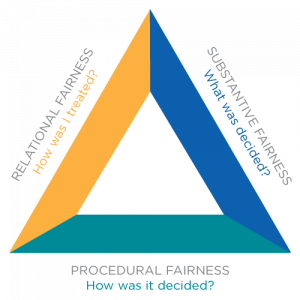Substantive Fairness
Substantive Fairness is about the decision itself. It asks the question: was the decision fair?
Generally, a fair decision must be:
- Based on relevant information
- Considerate of an individual’s needs and circumstances (equitable)
- Be made with appropriate authority
- Be based on the rules, however, the rules must also be fair
Examples:
A decision-maker declines a student’s request for an academic concession and writes in response that “in fairness to all students, I cannot approve this request, as the rules must be applied equally to all. Allowing this concession would be unfair for all those other students who are in similar situations.”
Without more explanation, this decision-maker has likely made a substantively unfair decision. This decision-maker is designated as the person to make customized decisions that are responsive to a student’s needs and circumstances. They have a duty to exercise discretion, which doesn’t mean saying yes every time, but does require them to take individual factors into account. A blanket no is substantively unfair.
An instructor puts a no tolerance attendance policy in their syllabus where an absence will reduce a student’s grade. After experiencing an unexpected and unavoidable circumstance causing a student to be absent for a class, the student asks that the grade not be reduced. The instructor says no, refers the student to the policy, and says that the decision is final.
The instructor has likely made a substantively unfair decision. The no tolerance policy is contrary to the University’s policy regarding academic concessions, where the policy states that reasonable efforts must be made to identify alternate academic arrangements and decision are appealable. The instructor does not have the authority to change the rules in the Academic Calendar by a statement in the syllabus.
Instead, the instructor ought to have referred the student to the academic concession process and should consider revising the no tolerance attendance policy for the future.
Tips for Decision-Makers:
- Ensure that you have the relevant information and that it is enough to make the decision.
- If you are unsure if you have authority or not to make a decision, reach out to double-check. Consider contacting the Ombudsperson for a confidential consultation.
- Write down the rationale for your decision. Ensure that you include what rules you are using to inform the decision. Mention all factors that the student has brought forth and show how they played into your decision.
- For academic integrity decisions consider using the Ombudsperson’s Template for an Academic Misconduct Decision Letter
The Ombudsperson’s Role
The Ombudsperson is an independent and impartial party who does not represent the University. It would therefore be inappropriate for the Ombudsperson to suggest or decide on what the outcome of a decision should be. Analyzing substantive fairness is a careful examination of certain factors about a decision — not a conclusion about if a decision is right or wrong.


